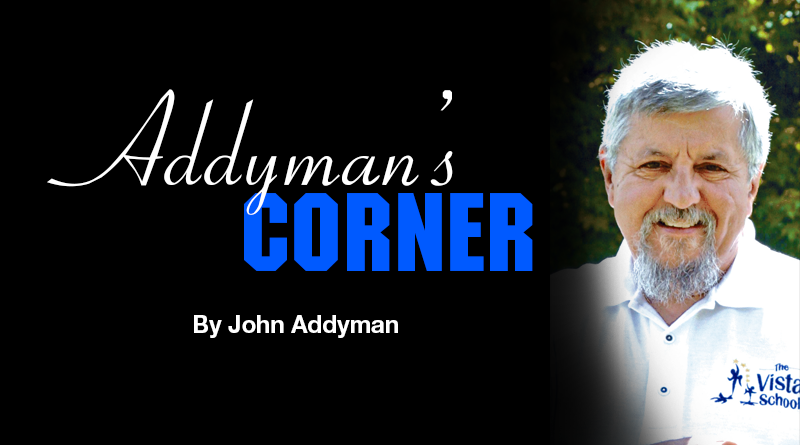The TV Whisperer and the Philco
By John Addyman
Email: john.addyman@yahoo.com
In Clark’s Green, the little town where I grew up north of Scranton, Pennsylvania, we had the first television on our block.
My dad liked to think he was an early adopter. He was a traveling furniture salesman and when he saw new stuff, he wanted to have it.
When bow-hunting became popular, he bought one for him and one for me and took me hunting. As it turned out, all woodland creatures great and small were entirely safe from my dad and me.
He liked his cars with a little styling to them, and that’s why he brought home a new Studebaker for my mom to see. As it turned out, the door fell off when he opened it for my mom. I am not kidding.
We always had the newest appliances. Waffle-makers, special toasters, coffee-makers…that kind of thing.
The TV my dad brought home was a Philco with a 12-inch screen, one speaker, and all the colors you could want as long as that included only black and white.
We could only get one station, WNBF, Channel 12 out of Binghamton, and that was only possible with a very large antenna my dad and one of his buddies, Reed Miller, installed on our roof, connected to the chimney.
The installation process, as I recall, required having my mom describe what was on the screen on the TV in our living room while my dad and his buddy moved the antenna around, trying to figure out where Binghamton was, to point the thing correctly.

My mom would yell to me, I was standing out on the front lawn, and I would yell up to the guys on the roof.
In those days, installation could take quite a while.
Occasionally, an empty beer can rolled off the roof in the process, marking the difficulty in the work to my 9-year-old mind.
Once properly connected, the TV was a hit. We had people show up at the house with food items, wrangling an invitation to stop and munch while they watched the TV. We were very popular for a while and then everybody else got TVs.
The TV was more than a piece of furniture. For instance, my parents would have a family New Year’s Eve party and the kids were allowed to stay up and watch TV. The only station on after midnight was the public broadcasting channel 44, which dusted off an original copy of Frankenstein every new year’s eve for our watching pleasure. I guess the station manager was a glass-half-empty kind of guy. I seem to recall one year he showed a double feature of Frankenstein and Bride of Frankenstein — we were up really late that night.
Our Philco had a stout chassis, but it was new technology in the 1950s, so performance was not consistent. Today you push a button on your remote and you instantly have a picture and sound. In the ‘50s, you got up, walked over to the TV and clicked the thing on, and you waited for the dancing electrons to line up and start to show you images.
Sometimes you didn’t get a picture, but “snow,” which was little dancing black-and-white dots that had a sound like a blanket being dragged down your street. Sometimes that meant the Philco had taken the day off. Sometimes WNBF-TV had taken the day off. Sometimes my little sister had turned the channel-selector knob to a channel we couldn’t receive and when you could only get one channel, there were a lot of “no-channel” choices. Flipping the channel selector to “12” sometimes cured the problem right away.
And sometimes the Philco was not feeling well. It was a beast full of vacuum tubes and circuits and electronic parts that got too hot and blew up or needed adjustment.
That’s when we called Ted Trishman, Clark’s Green’s TV repairman. He had a place of business that I swear never had the lights on inside. You’d walk in and not see anyone in there, in fact, not seeing much of anything at all except piles of sick TV sets waiting for the doctor.
You’d say, “Mr. Trishman, are you in here?”
“Hey, yeah!” he’d say, and you’d hear grinding noises like Gollum scraping over a cavern wall in Mordor.
And Mr. Trishman would stand up. Pop up, actually. He was a two-speed guy. When he wanted to be noticed, he’d pop up. When he didn’t, he’d go at a very slow speed. And he did it on purpose.
TVs in those days were boat anchors; you didn’t carry them into the store to get fixed. The store, Ted himself, would come to you. And I am forever grateful I have watched that happen several times.
He would get out of his truck slowly, like a gunslinger coming into town for the noon shoot-out. It was practiced. He’d pick up his equipment bag and his tube bag and head toward our front door.
Slow. Methodical. He’d linger to check the height of the grass.
Ted knew what he was doing. He was a TV whisperer. He knew that inside the Philco loomed a snarly, beggarly, irritating and smelly beast. And he was going to practice intimidation first. He never had to knock on the door; we held it open for him.
He put the tube satchel down gently. Inside were all manner of tubes, some in little boxes, and some in special separators in the bag. They were lined up by size and type, like bullets in the belt of a machine gun. He wanted to show the TV he was prepared.
But Ted dropped his tools satchel heavily on the floor, like a gauntlet being thrown. There would be no mistake as to who was in charge.
In truth, sometimes that’s all he had to do. The Philco was shivering in its capacitors by now and had fixed whatever was amiss all by itself. I swear that at least a third of the time Ted came to fix the Philco, he never had to lay a hand on the set. The thing gave up and popped into life as soon as he came to the door.
But the first couple of times, Ted had to establish who the alpha was in the room, thus, the tool satchel landing loudly on the floor.
Ted would turn dials and click the set on and off. Then he’d go for the jugular, opening up the baseboard panel on the back of the set. Now he had his iron tools and soldering gun on the soft parts of the Philco’s innards and the conquest was only a matter of time. He did not gently insert new tubes; he pushed them in with firm gusto. They snapped into place and the Philco flinched.
And when he was done, and the picture restored and sharp, Ted would screw in the last fastener and give the Philco a slap of authority.
Once Ted had established a relationship with our Philco, there were times when he fixed the TV just by coming into the house and putting his hands on the set. The Philco had learned nothing if not obedience.
And Ted would turn to my dad and say, “That’ll be $25.” And off he went.
Ted’s truck would drive away and we’d all turn to look at the Philco, which was still cowering in the corner of the living room.
I don’t suppose Ted Trishman is with us any longer, but if he were, I bet he wouldn’t remember me or my siblings watching him deal with our Philco…but as the TV whisperer, he’d always recall that Philco.

